EIT: Mobile Devices in Governance Report: Cloud and Security Aspects
VerifiedAdded on 2020/03/16
|17
|3993
|229
Report
AI Summary
This report, titled "Mobile Devices in Governance," explores the significant impact of mobile technology on modern governance systems. It begins with an introduction highlighting the widespread adoption of smartphones and the influence of cloud computing on making these devices more powerful and affordable, thereby enhancing government services and improving a country's productivity. The literature review then delves into the concepts of e-governance and m-governance, discussing the advantages and limitations of m-governance, including issues such as small phone sizes, security concerns, and digital divides. The report examines the tools used in mobile technology, including various operating systems like Android, iOS, and Windows Phone, and how they integrate with cloud services. It also analyzes government and citizen perceptions of mobile governance, including changing government mindsets and the benefits and challenges faced by citizens. The report addresses security challenges in cloud computing and suggests solutions to protect sensitive information. Finally, the report concludes with a summary of key findings and future references, emphasizing the transformative potential of mobile technology in improving public service delivery and citizen engagement.
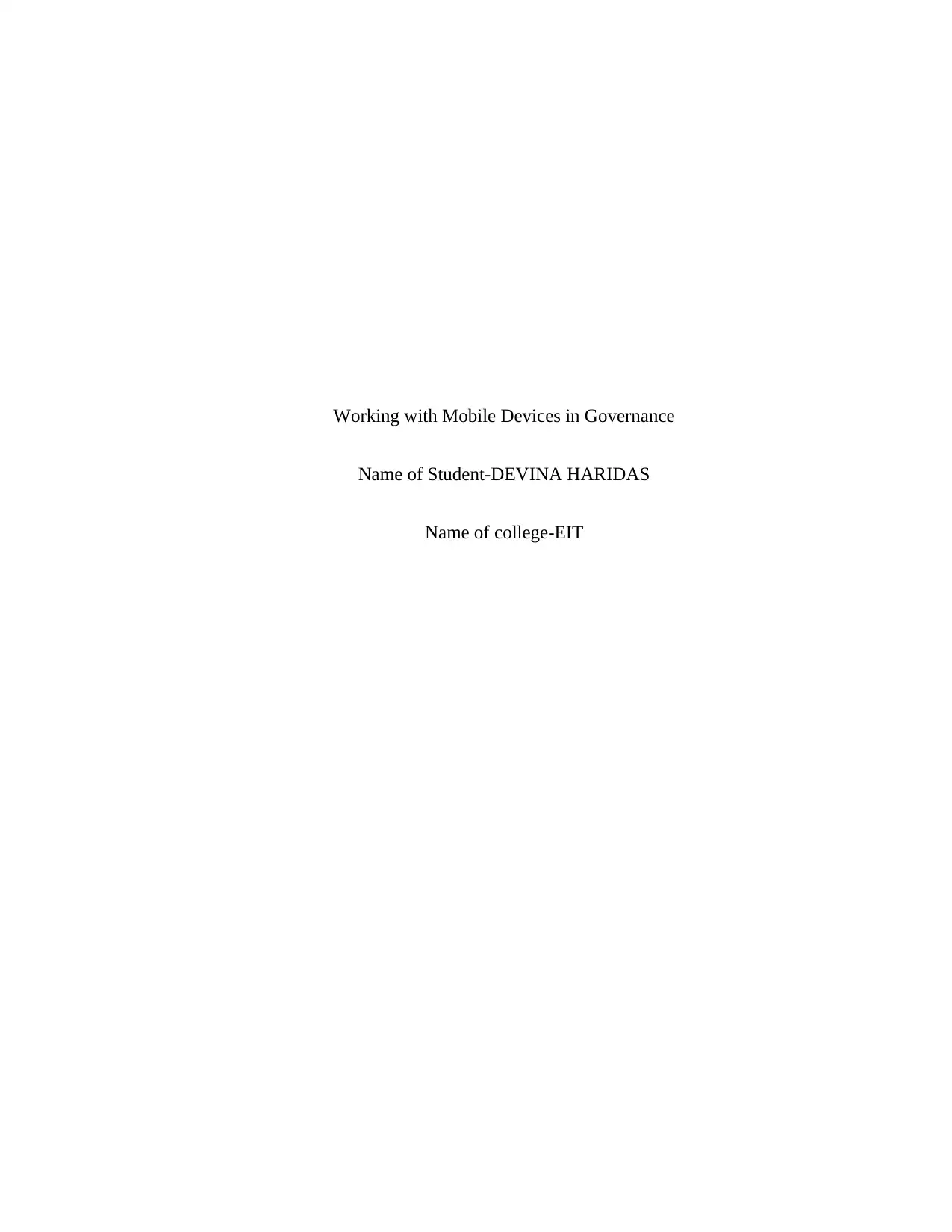
Working with Mobile Devices in Governance
Name of Student-DEVINA HARIDAS
Name of college-EIT
Name of Student-DEVINA HARIDAS
Name of college-EIT
Paraphrase This Document
Need a fresh take? Get an instant paraphrase of this document with our AI Paraphraser
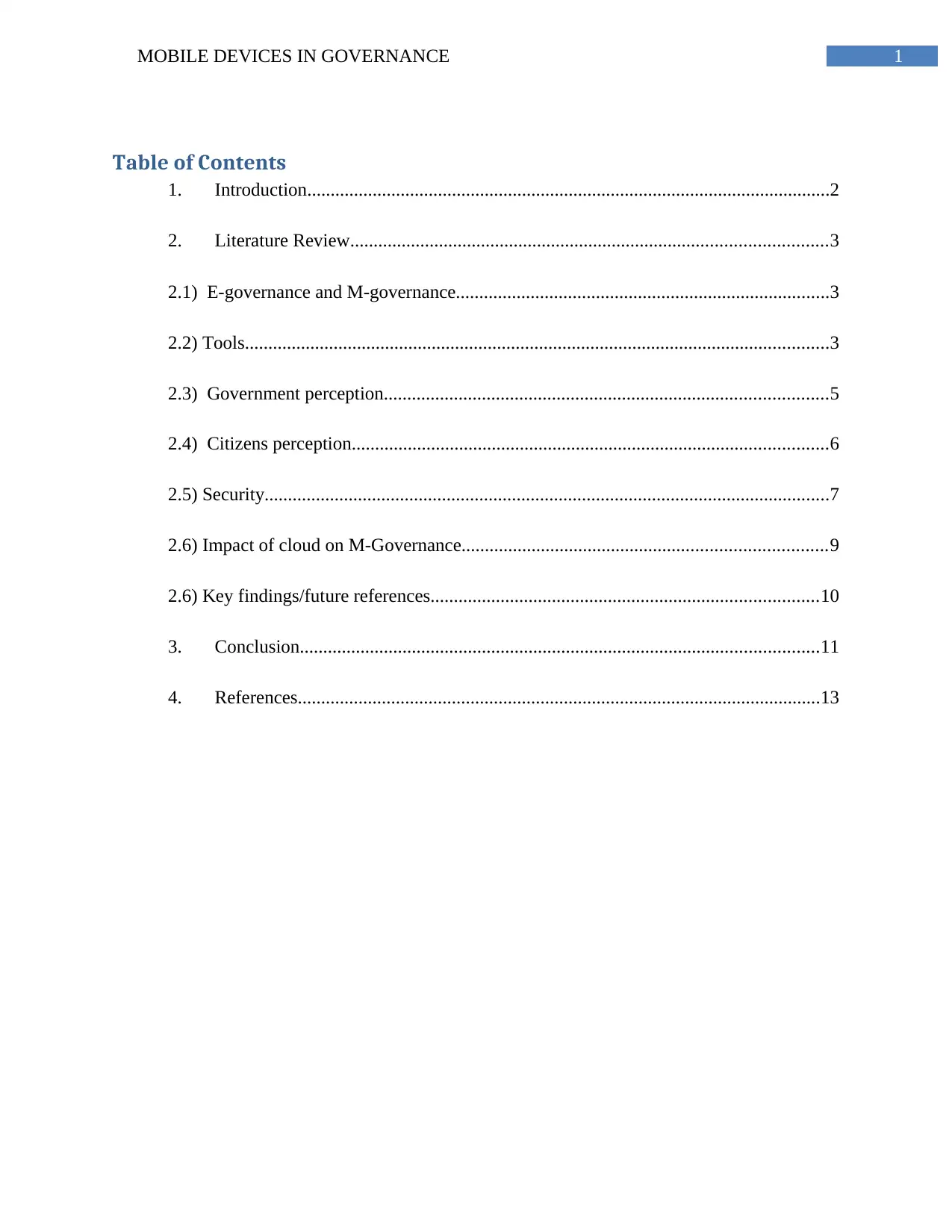
1MOBILE DEVICES IN GOVERNANCE
Table of Contents
1. Introduction................................................................................................................2
2. Literature Review......................................................................................................3
2.1) E-governance and M-governance................................................................................3
2.2) Tools.............................................................................................................................3
2.3) Government perception...............................................................................................5
2.4) Citizens perception......................................................................................................6
2.5) Security.........................................................................................................................7
2.6) Impact of cloud on M-Governance..............................................................................9
2.6) Key findings/future references...................................................................................10
3. Conclusion...............................................................................................................11
4. References................................................................................................................13
Table of Contents
1. Introduction................................................................................................................2
2. Literature Review......................................................................................................3
2.1) E-governance and M-governance................................................................................3
2.2) Tools.............................................................................................................................3
2.3) Government perception...............................................................................................5
2.4) Citizens perception......................................................................................................6
2.5) Security.........................................................................................................................7
2.6) Impact of cloud on M-Governance..............................................................................9
2.6) Key findings/future references...................................................................................10
3. Conclusion...............................................................................................................11
4. References................................................................................................................13
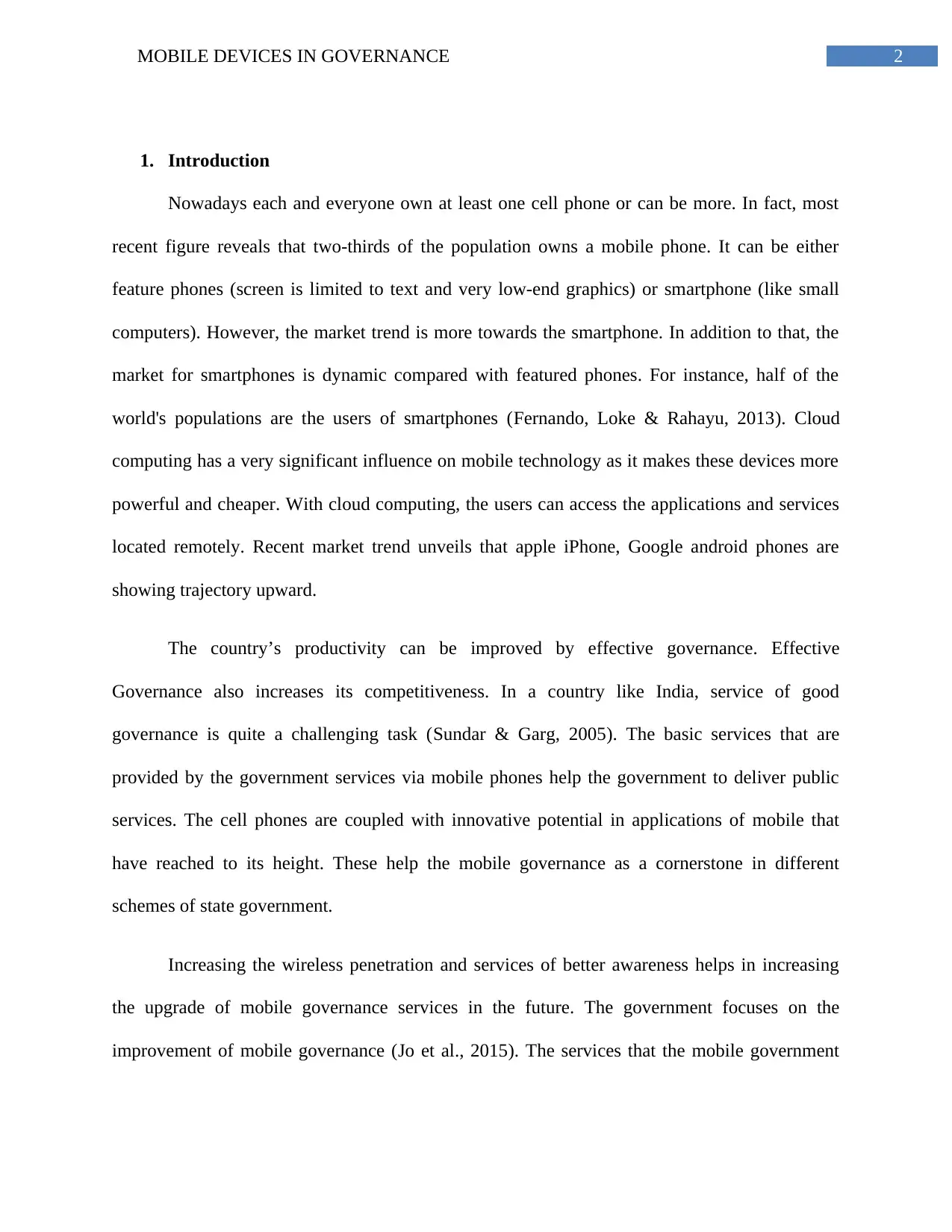
2MOBILE DEVICES IN GOVERNANCE
1. Introduction
Nowadays each and everyone own at least one cell phone or can be more. In fact, most
recent figure reveals that two-thirds of the population owns a mobile phone. It can be either
feature phones (screen is limited to text and very low-end graphics) or smartphone (like small
computers). However, the market trend is more towards the smartphone. In addition to that, the
market for smartphones is dynamic compared with featured phones. For instance, half of the
world's populations are the users of smartphones (Fernando, Loke & Rahayu, 2013). Cloud
computing has a very significant influence on mobile technology as it makes these devices more
powerful and cheaper. With cloud computing, the users can access the applications and services
located remotely. Recent market trend unveils that apple iPhone, Google android phones are
showing trajectory upward.
The country’s productivity can be improved by effective governance. Effective
Governance also increases its competitiveness. In a country like India, service of good
governance is quite a challenging task (Sundar & Garg, 2005). The basic services that are
provided by the government services via mobile phones help the government to deliver public
services. The cell phones are coupled with innovative potential in applications of mobile that
have reached to its height. These help the mobile governance as a cornerstone in different
schemes of state government.
Increasing the wireless penetration and services of better awareness helps in increasing
the upgrade of mobile governance services in the future. The government focuses on the
improvement of mobile governance (Jo et al., 2015). The services that the mobile government
1. Introduction
Nowadays each and everyone own at least one cell phone or can be more. In fact, most
recent figure reveals that two-thirds of the population owns a mobile phone. It can be either
feature phones (screen is limited to text and very low-end graphics) or smartphone (like small
computers). However, the market trend is more towards the smartphone. In addition to that, the
market for smartphones is dynamic compared with featured phones. For instance, half of the
world's populations are the users of smartphones (Fernando, Loke & Rahayu, 2013). Cloud
computing has a very significant influence on mobile technology as it makes these devices more
powerful and cheaper. With cloud computing, the users can access the applications and services
located remotely. Recent market trend unveils that apple iPhone, Google android phones are
showing trajectory upward.
The country’s productivity can be improved by effective governance. Effective
Governance also increases its competitiveness. In a country like India, service of good
governance is quite a challenging task (Sundar & Garg, 2005). The basic services that are
provided by the government services via mobile phones help the government to deliver public
services. The cell phones are coupled with innovative potential in applications of mobile that
have reached to its height. These help the mobile governance as a cornerstone in different
schemes of state government.
Increasing the wireless penetration and services of better awareness helps in increasing
the upgrade of mobile governance services in the future. The government focuses on the
improvement of mobile governance (Jo et al., 2015). The services that the mobile government
⊘ This is a preview!⊘
Do you want full access?
Subscribe today to unlock all pages.

Trusted by 1+ million students worldwide
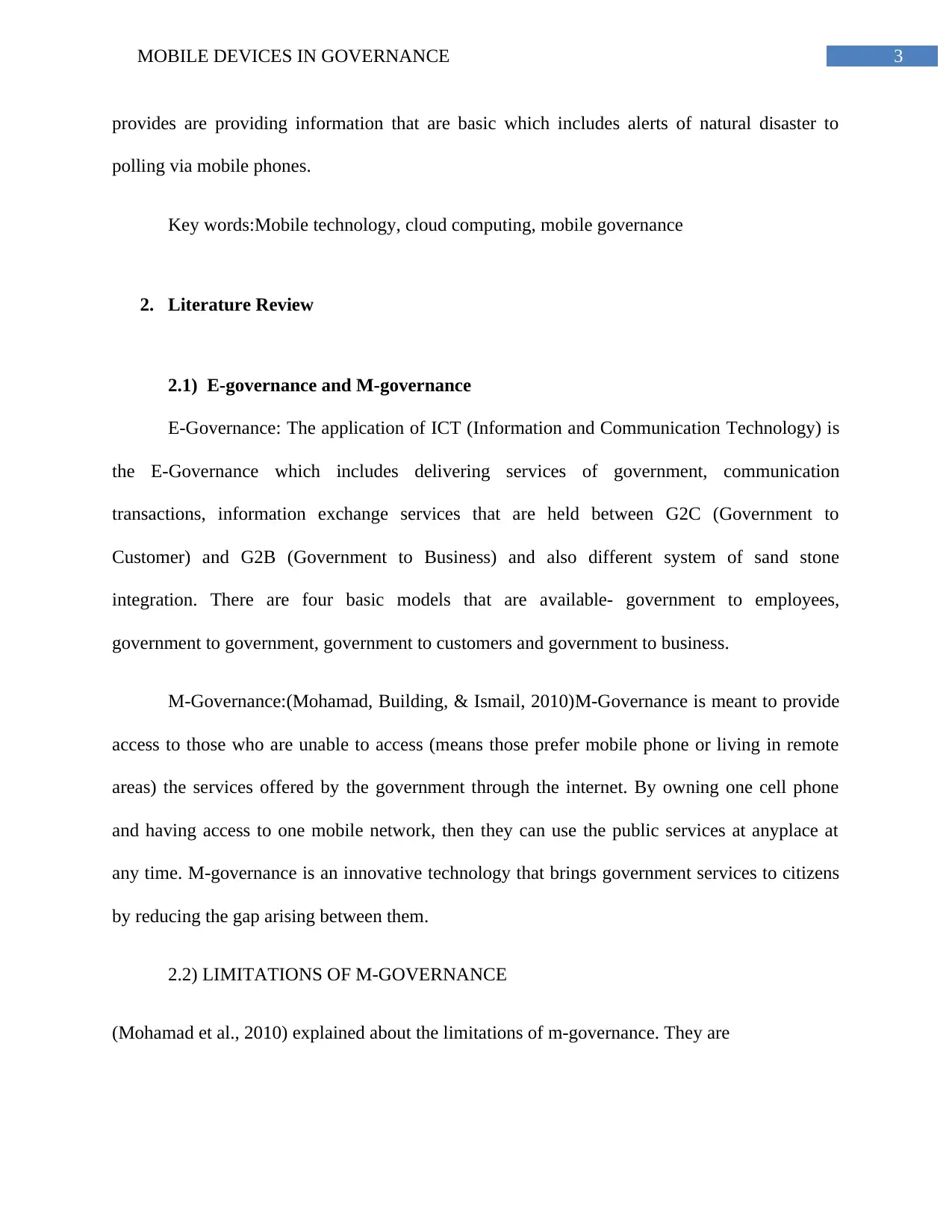
3MOBILE DEVICES IN GOVERNANCE
provides are providing information that are basic which includes alerts of natural disaster to
polling via mobile phones.
Key words:Mobile technology, cloud computing, mobile governance
2. Literature Review
2.1) E-governance and M-governance
E-Governance: The application of ICT (Information and Communication Technology) is
the E-Governance which includes delivering services of government, communication
transactions, information exchange services that are held between G2C (Government to
Customer) and G2B (Government to Business) and also different system of sand stone
integration. There are four basic models that are available- government to employees,
government to government, government to customers and government to business.
M-Governance:(Mohamad, Building, & Ismail, 2010)M-Governance is meant to provide
access to those who are unable to access (means those prefer mobile phone or living in remote
areas) the services offered by the government through the internet. By owning one cell phone
and having access to one mobile network, then they can use the public services at anyplace at
any time. M-governance is an innovative technology that brings government services to citizens
by reducing the gap arising between them.
2.2) LIMITATIONS OF M-GOVERNANCE
(Mohamad et al., 2010) explained about the limitations of m-governance. They are
provides are providing information that are basic which includes alerts of natural disaster to
polling via mobile phones.
Key words:Mobile technology, cloud computing, mobile governance
2. Literature Review
2.1) E-governance and M-governance
E-Governance: The application of ICT (Information and Communication Technology) is
the E-Governance which includes delivering services of government, communication
transactions, information exchange services that are held between G2C (Government to
Customer) and G2B (Government to Business) and also different system of sand stone
integration. There are four basic models that are available- government to employees,
government to government, government to customers and government to business.
M-Governance:(Mohamad, Building, & Ismail, 2010)M-Governance is meant to provide
access to those who are unable to access (means those prefer mobile phone or living in remote
areas) the services offered by the government through the internet. By owning one cell phone
and having access to one mobile network, then they can use the public services at anyplace at
any time. M-governance is an innovative technology that brings government services to citizens
by reducing the gap arising between them.
2.2) LIMITATIONS OF M-GOVERNANCE
(Mohamad et al., 2010) explained about the limitations of m-governance. They are
Paraphrase This Document
Need a fresh take? Get an instant paraphrase of this document with our AI Paraphraser
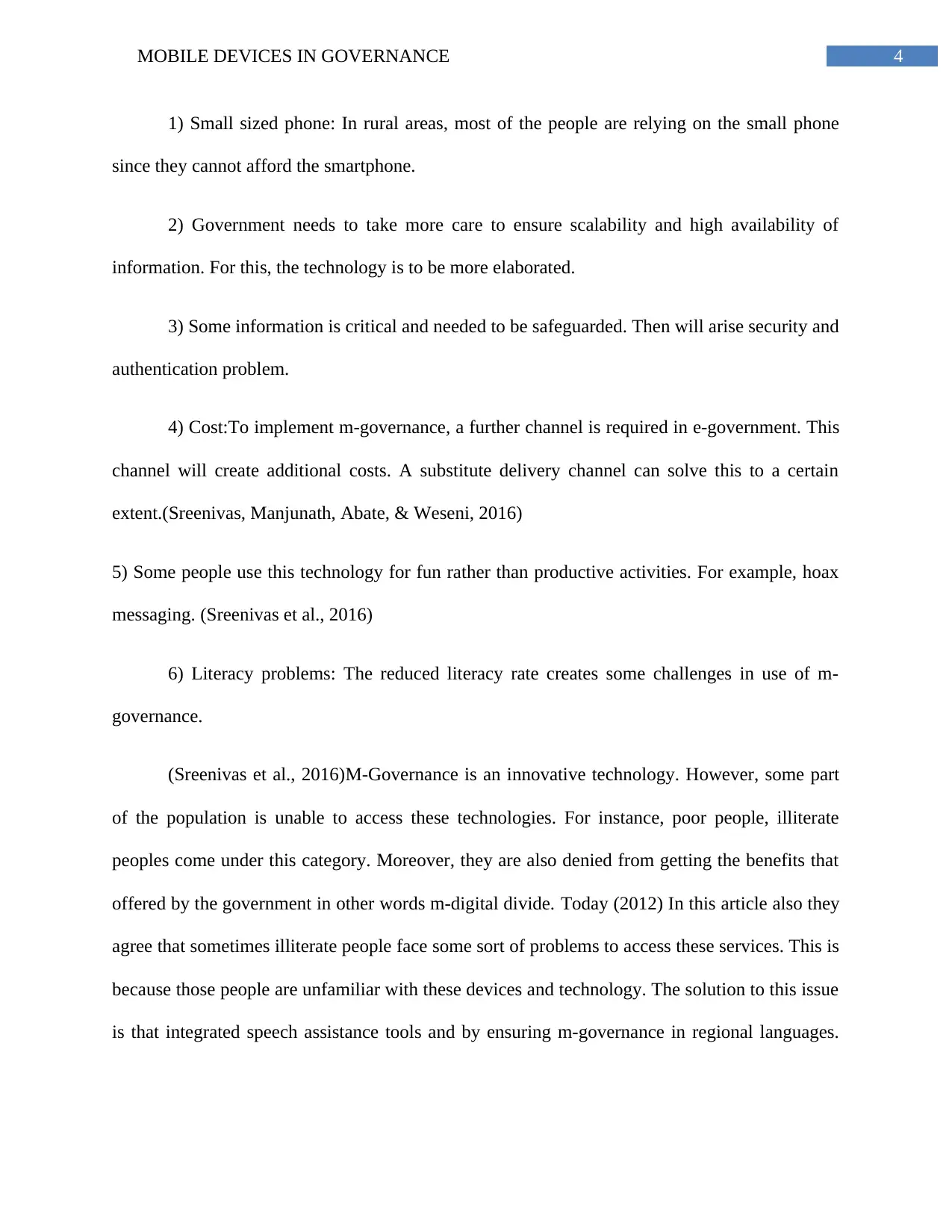
4MOBILE DEVICES IN GOVERNANCE
1) Small sized phone: In rural areas, most of the people are relying on the small phone
since they cannot afford the smartphone.
2) Government needs to take more care to ensure scalability and high availability of
information. For this, the technology is to be more elaborated.
3) Some information is critical and needed to be safeguarded. Then will arise security and
authentication problem.
4) Cost:To implement m-governance, a further channel is required in e-government. This
channel will create additional costs. A substitute delivery channel can solve this to a certain
extent.(Sreenivas, Manjunath, Abate, & Weseni, 2016)
5) Some people use this technology for fun rather than productive activities. For example, hoax
messaging. (Sreenivas et al., 2016)
6) Literacy problems: The reduced literacy rate creates some challenges in use of m-
governance.
(Sreenivas et al., 2016)M-Governance is an innovative technology. However, some part
of the population is unable to access these technologies. For instance, poor people, illiterate
peoples come under this category. Moreover, they are also denied from getting the benefits that
offered by the government in other words m-digital divide. Today (2012) In this article also they
agree that sometimes illiterate people face some sort of problems to access these services. This is
because those people are unfamiliar with these devices and technology. The solution to this issue
is that integrated speech assistance tools and by ensuring m-governance in regional languages.
1) Small sized phone: In rural areas, most of the people are relying on the small phone
since they cannot afford the smartphone.
2) Government needs to take more care to ensure scalability and high availability of
information. For this, the technology is to be more elaborated.
3) Some information is critical and needed to be safeguarded. Then will arise security and
authentication problem.
4) Cost:To implement m-governance, a further channel is required in e-government. This
channel will create additional costs. A substitute delivery channel can solve this to a certain
extent.(Sreenivas, Manjunath, Abate, & Weseni, 2016)
5) Some people use this technology for fun rather than productive activities. For example, hoax
messaging. (Sreenivas et al., 2016)
6) Literacy problems: The reduced literacy rate creates some challenges in use of m-
governance.
(Sreenivas et al., 2016)M-Governance is an innovative technology. However, some part
of the population is unable to access these technologies. For instance, poor people, illiterate
peoples come under this category. Moreover, they are also denied from getting the benefits that
offered by the government in other words m-digital divide. Today (2012) In this article also they
agree that sometimes illiterate people face some sort of problems to access these services. This is
because those people are unfamiliar with these devices and technology. The solution to this issue
is that integrated speech assistance tools and by ensuring m-governance in regional languages.
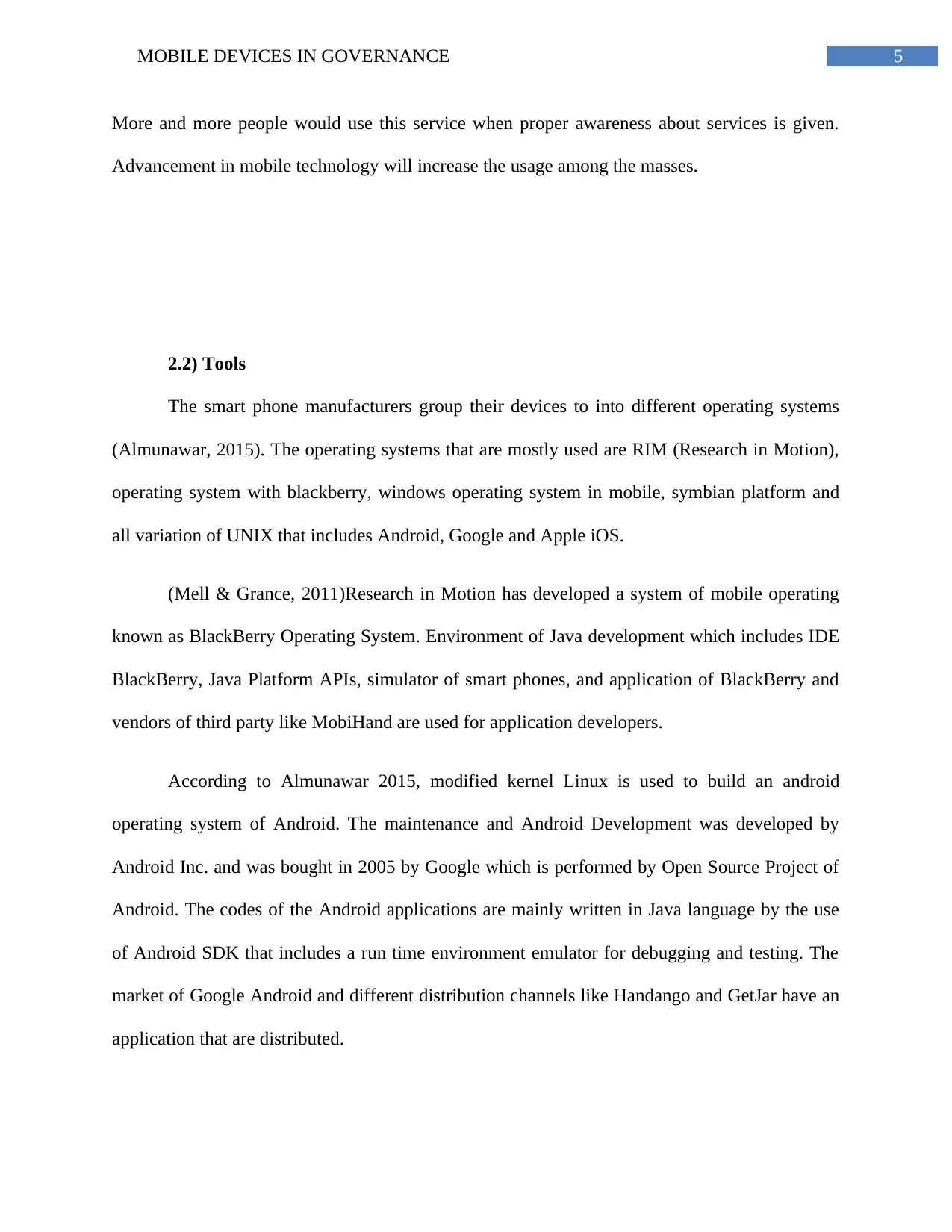
5MOBILE DEVICES IN GOVERNANCE
More and more people would use this service when proper awareness about services is given.
Advancement in mobile technology will increase the usage among the masses.
2.2) Tools
The smart phone manufacturers group their devices to into different operating systems
(Almunawar, 2015). The operating systems that are mostly used are RIM (Research in Motion),
operating system with blackberry, windows operating system in mobile, symbian platform and
all variation of UNIX that includes Android, Google and Apple iOS.
(Mell & Grance, 2011)Research in Motion has developed a system of mobile operating
known as BlackBerry Operating System. Environment of Java development which includes IDE
BlackBerry, Java Platform APIs, simulator of smart phones, and application of BlackBerry and
vendors of third party like MobiHand are used for application developers.
According to Almunawar 2015, modified kernel Linux is used to build an android
operating system of Android. The maintenance and Android Development was developed by
Android Inc. and was bought in 2005 by Google which is performed by Open Source Project of
Android. The codes of the Android applications are mainly written in Java language by the use
of Android SDK that includes a run time environment emulator for debugging and testing. The
market of Google Android and different distribution channels like Handango and GetJar have an
application that are distributed.
More and more people would use this service when proper awareness about services is given.
Advancement in mobile technology will increase the usage among the masses.
2.2) Tools
The smart phone manufacturers group their devices to into different operating systems
(Almunawar, 2015). The operating systems that are mostly used are RIM (Research in Motion),
operating system with blackberry, windows operating system in mobile, symbian platform and
all variation of UNIX that includes Android, Google and Apple iOS.
(Mell & Grance, 2011)Research in Motion has developed a system of mobile operating
known as BlackBerry Operating System. Environment of Java development which includes IDE
BlackBerry, Java Platform APIs, simulator of smart phones, and application of BlackBerry and
vendors of third party like MobiHand are used for application developers.
According to Almunawar 2015, modified kernel Linux is used to build an android
operating system of Android. The maintenance and Android Development was developed by
Android Inc. and was bought in 2005 by Google which is performed by Open Source Project of
Android. The codes of the Android applications are mainly written in Java language by the use
of Android SDK that includes a run time environment emulator for debugging and testing. The
market of Google Android and different distribution channels like Handango and GetJar have an
application that are distributed.
⊘ This is a preview!⊘
Do you want full access?
Subscribe today to unlock all pages.

Trusted by 1+ million students worldwide
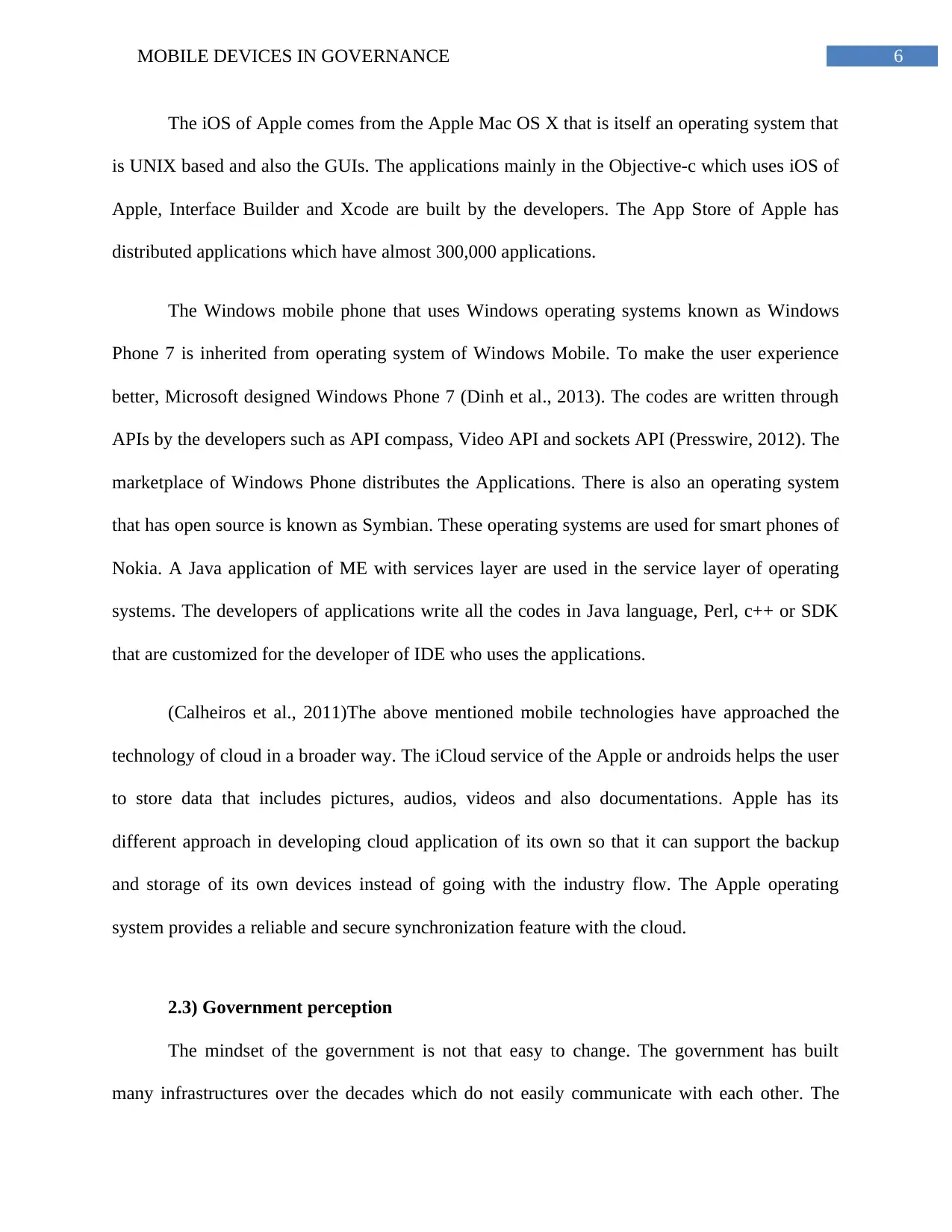
6MOBILE DEVICES IN GOVERNANCE
The iOS of Apple comes from the Apple Mac OS X that is itself an operating system that
is UNIX based and also the GUIs. The applications mainly in the Objective-c which uses iOS of
Apple, Interface Builder and Xcode are built by the developers. The App Store of Apple has
distributed applications which have almost 300,000 applications.
The Windows mobile phone that uses Windows operating systems known as Windows
Phone 7 is inherited from operating system of Windows Mobile. To make the user experience
better, Microsoft designed Windows Phone 7 (Dinh et al., 2013). The codes are written through
APIs by the developers such as API compass, Video API and sockets API (Presswire, 2012). The
marketplace of Windows Phone distributes the Applications. There is also an operating system
that has open source is known as Symbian. These operating systems are used for smart phones of
Nokia. A Java application of ME with services layer are used in the service layer of operating
systems. The developers of applications write all the codes in Java language, Perl, c++ or SDK
that are customized for the developer of IDE who uses the applications.
(Calheiros et al., 2011)The above mentioned mobile technologies have approached the
technology of cloud in a broader way. The iCloud service of the Apple or androids helps the user
to store data that includes pictures, audios, videos and also documentations. Apple has its
different approach in developing cloud application of its own so that it can support the backup
and storage of its own devices instead of going with the industry flow. The Apple operating
system provides a reliable and secure synchronization feature with the cloud.
2.3) Government perception
The mindset of the government is not that easy to change. The government has built
many infrastructures over the decades which do not easily communicate with each other. The
The iOS of Apple comes from the Apple Mac OS X that is itself an operating system that
is UNIX based and also the GUIs. The applications mainly in the Objective-c which uses iOS of
Apple, Interface Builder and Xcode are built by the developers. The App Store of Apple has
distributed applications which have almost 300,000 applications.
The Windows mobile phone that uses Windows operating systems known as Windows
Phone 7 is inherited from operating system of Windows Mobile. To make the user experience
better, Microsoft designed Windows Phone 7 (Dinh et al., 2013). The codes are written through
APIs by the developers such as API compass, Video API and sockets API (Presswire, 2012). The
marketplace of Windows Phone distributes the Applications. There is also an operating system
that has open source is known as Symbian. These operating systems are used for smart phones of
Nokia. A Java application of ME with services layer are used in the service layer of operating
systems. The developers of applications write all the codes in Java language, Perl, c++ or SDK
that are customized for the developer of IDE who uses the applications.
(Calheiros et al., 2011)The above mentioned mobile technologies have approached the
technology of cloud in a broader way. The iCloud service of the Apple or androids helps the user
to store data that includes pictures, audios, videos and also documentations. Apple has its
different approach in developing cloud application of its own so that it can support the backup
and storage of its own devices instead of going with the industry flow. The Apple operating
system provides a reliable and secure synchronization feature with the cloud.
2.3) Government perception
The mindset of the government is not that easy to change. The government has built
many infrastructures over the decades which do not easily communicate with each other. The
Paraphrase This Document
Need a fresh take? Get an instant paraphrase of this document with our AI Paraphraser
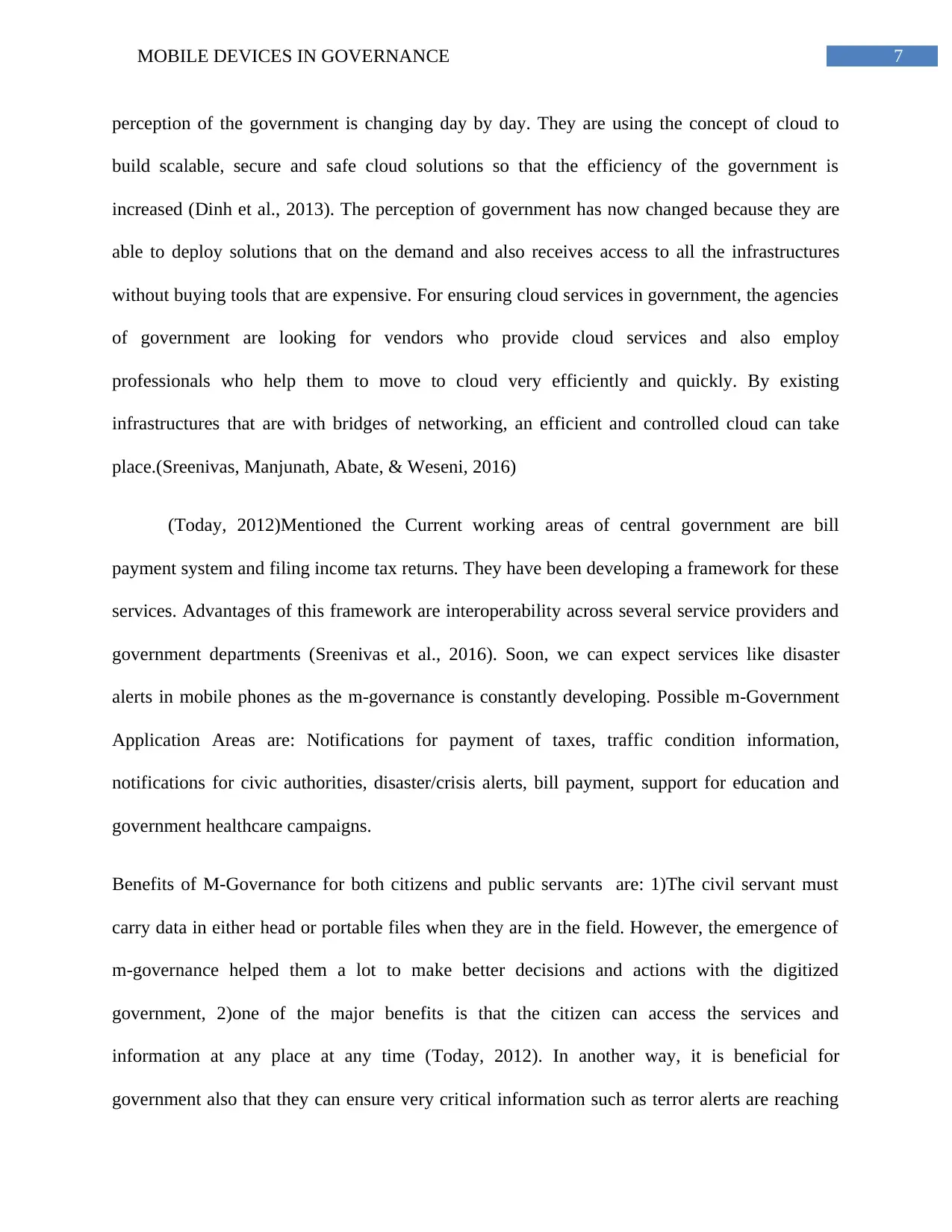
7MOBILE DEVICES IN GOVERNANCE
perception of the government is changing day by day. They are using the concept of cloud to
build scalable, secure and safe cloud solutions so that the efficiency of the government is
increased (Dinh et al., 2013). The perception of government has now changed because they are
able to deploy solutions that on the demand and also receives access to all the infrastructures
without buying tools that are expensive. For ensuring cloud services in government, the agencies
of government are looking for vendors who provide cloud services and also employ
professionals who help them to move to cloud very efficiently and quickly. By existing
infrastructures that are with bridges of networking, an efficient and controlled cloud can take
place.(Sreenivas, Manjunath, Abate, & Weseni, 2016)
(Today, 2012)Mentioned the Current working areas of central government are bill
payment system and filing income tax returns. They have been developing a framework for these
services. Advantages of this framework are interoperability across several service providers and
government departments (Sreenivas et al., 2016). Soon, we can expect services like disaster
alerts in mobile phones as the m-governance is constantly developing. Possible m-Government
Application Areas are: Notifications for payment of taxes, traffic condition information,
notifications for civic authorities, disaster/crisis alerts, bill payment, support for education and
government healthcare campaigns.
Benefits of M-Governance for both citizens and public servants are: 1)The civil servant must
carry data in either head or portable files when they are in the field. However, the emergence of
m-governance helped them a lot to make better decisions and actions with the digitized
government, 2)one of the major benefits is that the citizen can access the services and
information at any place at any time (Today, 2012). In another way, it is beneficial for
government also that they can ensure very critical information such as terror alerts are reaching
perception of the government is changing day by day. They are using the concept of cloud to
build scalable, secure and safe cloud solutions so that the efficiency of the government is
increased (Dinh et al., 2013). The perception of government has now changed because they are
able to deploy solutions that on the demand and also receives access to all the infrastructures
without buying tools that are expensive. For ensuring cloud services in government, the agencies
of government are looking for vendors who provide cloud services and also employ
professionals who help them to move to cloud very efficiently and quickly. By existing
infrastructures that are with bridges of networking, an efficient and controlled cloud can take
place.(Sreenivas, Manjunath, Abate, & Weseni, 2016)
(Today, 2012)Mentioned the Current working areas of central government are bill
payment system and filing income tax returns. They have been developing a framework for these
services. Advantages of this framework are interoperability across several service providers and
government departments (Sreenivas et al., 2016). Soon, we can expect services like disaster
alerts in mobile phones as the m-governance is constantly developing. Possible m-Government
Application Areas are: Notifications for payment of taxes, traffic condition information,
notifications for civic authorities, disaster/crisis alerts, bill payment, support for education and
government healthcare campaigns.
Benefits of M-Governance for both citizens and public servants are: 1)The civil servant must
carry data in either head or portable files when they are in the field. However, the emergence of
m-governance helped them a lot to make better decisions and actions with the digitized
government, 2)one of the major benefits is that the citizen can access the services and
information at any place at any time (Today, 2012). In another way, it is beneficial for
government also that they can ensure very critical information such as terror alerts are reaching
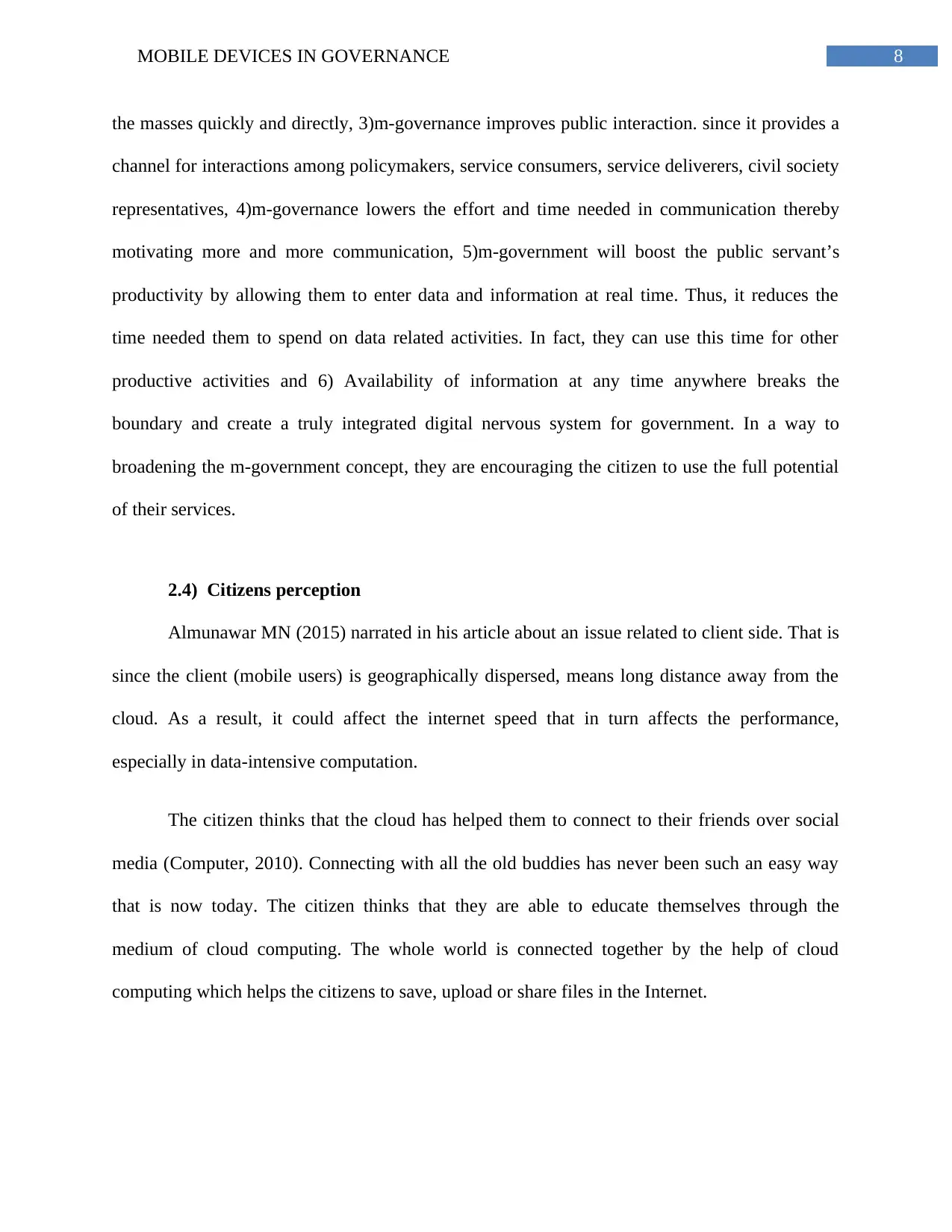
8MOBILE DEVICES IN GOVERNANCE
the masses quickly and directly, 3)m-governance improves public interaction. since it provides a
channel for interactions among policymakers, service consumers, service deliverers, civil society
representatives, 4)m-governance lowers the effort and time needed in communication thereby
motivating more and more communication, 5)m-government will boost the public servant’s
productivity by allowing them to enter data and information at real time. Thus, it reduces the
time needed them to spend on data related activities. In fact, they can use this time for other
productive activities and 6) Availability of information at any time anywhere breaks the
boundary and create a truly integrated digital nervous system for government. In a way to
broadening the m-government concept, they are encouraging the citizen to use the full potential
of their services.
2.4) Citizens perception
Almunawar MN (2015) narrated in his article about an issue related to client side. That is
since the client (mobile users) is geographically dispersed, means long distance away from the
cloud. As a result, it could affect the internet speed that in turn affects the performance,
especially in data-intensive computation.
The citizen thinks that the cloud has helped them to connect to their friends over social
media (Computer, 2010). Connecting with all the old buddies has never been such an easy way
that is now today. The citizen thinks that they are able to educate themselves through the
medium of cloud computing. The whole world is connected together by the help of cloud
computing which helps the citizens to save, upload or share files in the Internet.
the masses quickly and directly, 3)m-governance improves public interaction. since it provides a
channel for interactions among policymakers, service consumers, service deliverers, civil society
representatives, 4)m-governance lowers the effort and time needed in communication thereby
motivating more and more communication, 5)m-government will boost the public servant’s
productivity by allowing them to enter data and information at real time. Thus, it reduces the
time needed them to spend on data related activities. In fact, they can use this time for other
productive activities and 6) Availability of information at any time anywhere breaks the
boundary and create a truly integrated digital nervous system for government. In a way to
broadening the m-government concept, they are encouraging the citizen to use the full potential
of their services.
2.4) Citizens perception
Almunawar MN (2015) narrated in his article about an issue related to client side. That is
since the client (mobile users) is geographically dispersed, means long distance away from the
cloud. As a result, it could affect the internet speed that in turn affects the performance,
especially in data-intensive computation.
The citizen thinks that the cloud has helped them to connect to their friends over social
media (Computer, 2010). Connecting with all the old buddies has never been such an easy way
that is now today. The citizen thinks that they are able to educate themselves through the
medium of cloud computing. The whole world is connected together by the help of cloud
computing which helps the citizens to save, upload or share files in the Internet.
⊘ This is a preview!⊘
Do you want full access?
Subscribe today to unlock all pages.

Trusted by 1+ million students worldwide
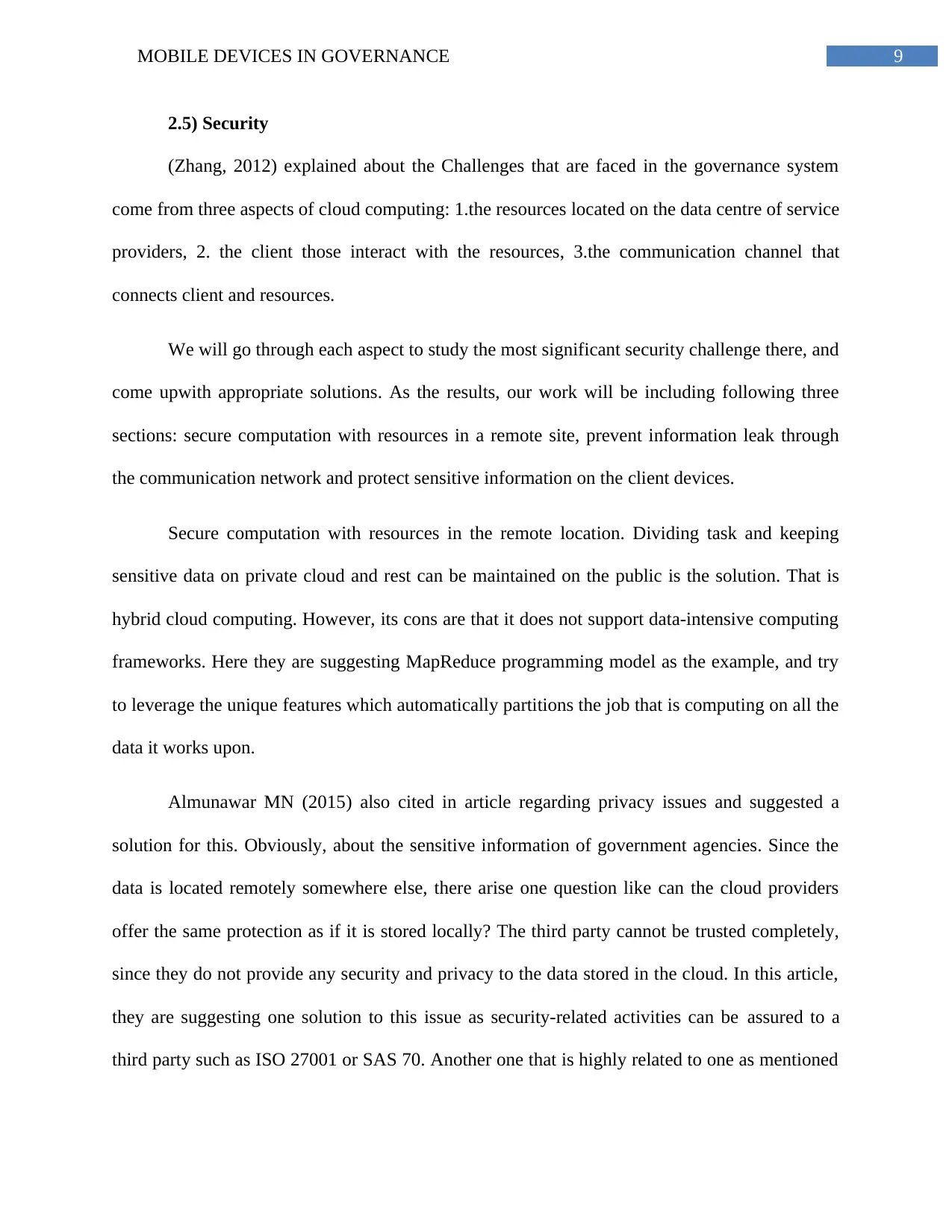
9MOBILE DEVICES IN GOVERNANCE
2.5) Security
(Zhang, 2012) explained about the Challenges that are faced in the governance system
come from three aspects of cloud computing: 1.the resources located on the data centre of service
providers, 2. the client those interact with the resources, 3.the communication channel that
connects client and resources.
We will go through each aspect to study the most significant security challenge there, and
come upwith appropriate solutions. As the results, our work will be including following three
sections: secure computation with resources in a remote site, prevent information leak through
the communication network and protect sensitive information on the client devices.
Secure computation with resources in the remote location. Dividing task and keeping
sensitive data on private cloud and rest can be maintained on the public is the solution. That is
hybrid cloud computing. However, its cons are that it does not support data-intensive computing
frameworks. Here they are suggesting MapReduce programming model as the example, and try
to leverage the unique features which automatically partitions the job that is computing on all the
data it works upon.
Almunawar MN (2015) also cited in article regarding privacy issues and suggested a
solution for this. Obviously, about the sensitive information of government agencies. Since the
data is located remotely somewhere else, there arise one question like can the cloud providers
offer the same protection as if it is stored locally? The third party cannot be trusted completely,
since they do not provide any security and privacy to the data stored in the cloud. In this article,
they are suggesting one solution to this issue as security-related activities can be assured to a
third party such as ISO 27001 or SAS 70. Another one that is highly related to one as mentioned
2.5) Security
(Zhang, 2012) explained about the Challenges that are faced in the governance system
come from three aspects of cloud computing: 1.the resources located on the data centre of service
providers, 2. the client those interact with the resources, 3.the communication channel that
connects client and resources.
We will go through each aspect to study the most significant security challenge there, and
come upwith appropriate solutions. As the results, our work will be including following three
sections: secure computation with resources in a remote site, prevent information leak through
the communication network and protect sensitive information on the client devices.
Secure computation with resources in the remote location. Dividing task and keeping
sensitive data on private cloud and rest can be maintained on the public is the solution. That is
hybrid cloud computing. However, its cons are that it does not support data-intensive computing
frameworks. Here they are suggesting MapReduce programming model as the example, and try
to leverage the unique features which automatically partitions the job that is computing on all the
data it works upon.
Almunawar MN (2015) also cited in article regarding privacy issues and suggested a
solution for this. Obviously, about the sensitive information of government agencies. Since the
data is located remotely somewhere else, there arise one question like can the cloud providers
offer the same protection as if it is stored locally? The third party cannot be trusted completely,
since they do not provide any security and privacy to the data stored in the cloud. In this article,
they are suggesting one solution to this issue as security-related activities can be assured to a
third party such as ISO 27001 or SAS 70. Another one that is highly related to one as mentioned
Paraphrase This Document
Need a fresh take? Get an instant paraphrase of this document with our AI Paraphraser
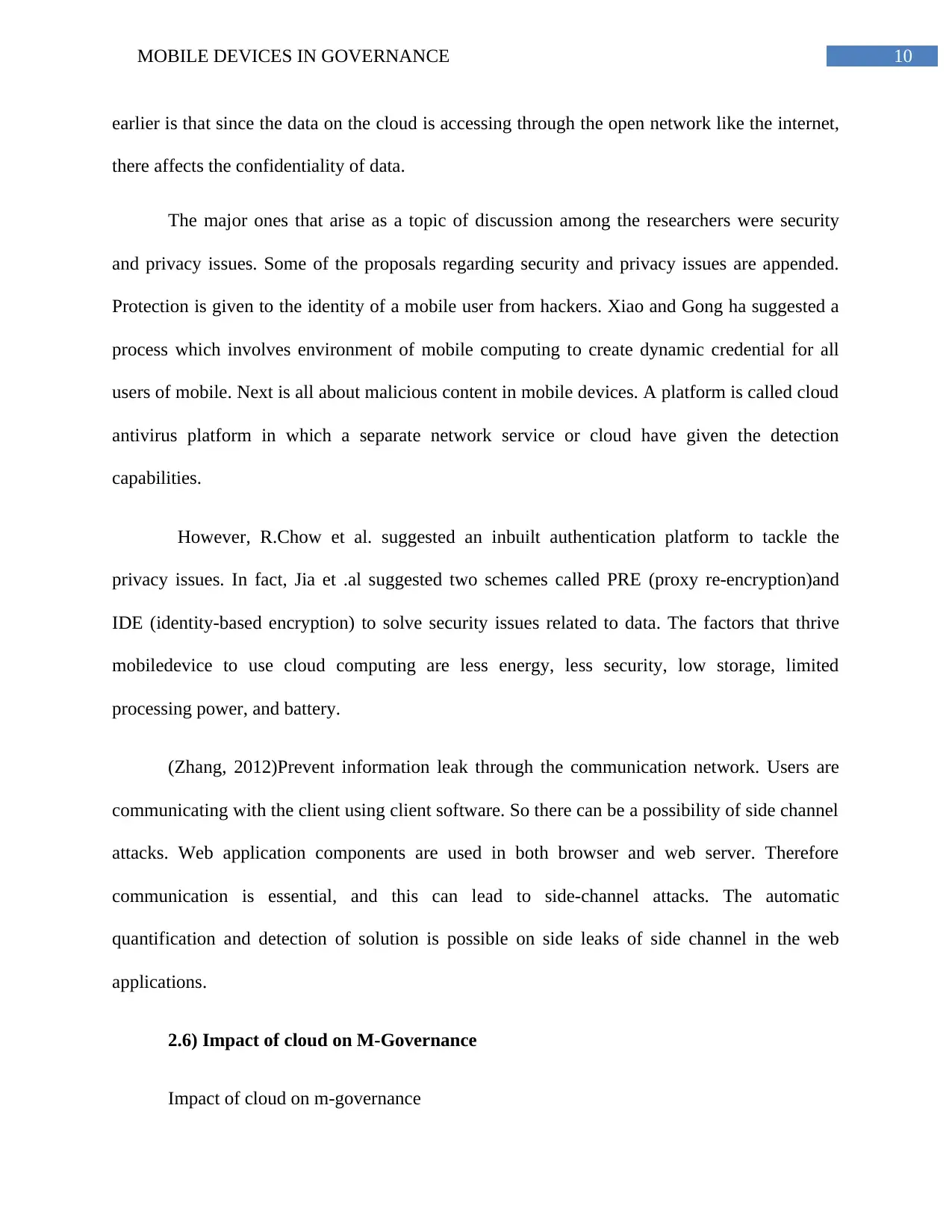
10MOBILE DEVICES IN GOVERNANCE
earlier is that since the data on the cloud is accessing through the open network like the internet,
there affects the confidentiality of data.
The major ones that arise as a topic of discussion among the researchers were security
and privacy issues. Some of the proposals regarding security and privacy issues are appended.
Protection is given to the identity of a mobile user from hackers. Xiao and Gong ha suggested a
process which involves environment of mobile computing to create dynamic credential for all
users of mobile. Next is all about malicious content in mobile devices. A platform is called cloud
antivirus platform in which a separate network service or cloud have given the detection
capabilities.
However, R.Chow et al. suggested an inbuilt authentication platform to tackle the
privacy issues. In fact, Jia et .al suggested two schemes called PRE (proxy re-encryption)and
IDE (identity-based encryption) to solve security issues related to data. The factors that thrive
mobiledevice to use cloud computing are less energy, less security, low storage, limited
processing power, and battery.
(Zhang, 2012)Prevent information leak through the communication network. Users are
communicating with the client using client software. So there can be a possibility of side channel
attacks. Web application components are used in both browser and web server. Therefore
communication is essential, and this can lead to side-channel attacks. The automatic
quantification and detection of solution is possible on side leaks of side channel in the web
applications.
2.6) Impact of cloud on M-Governance
Impact of cloud on m-governance
earlier is that since the data on the cloud is accessing through the open network like the internet,
there affects the confidentiality of data.
The major ones that arise as a topic of discussion among the researchers were security
and privacy issues. Some of the proposals regarding security and privacy issues are appended.
Protection is given to the identity of a mobile user from hackers. Xiao and Gong ha suggested a
process which involves environment of mobile computing to create dynamic credential for all
users of mobile. Next is all about malicious content in mobile devices. A platform is called cloud
antivirus platform in which a separate network service or cloud have given the detection
capabilities.
However, R.Chow et al. suggested an inbuilt authentication platform to tackle the
privacy issues. In fact, Jia et .al suggested two schemes called PRE (proxy re-encryption)and
IDE (identity-based encryption) to solve security issues related to data. The factors that thrive
mobiledevice to use cloud computing are less energy, less security, low storage, limited
processing power, and battery.
(Zhang, 2012)Prevent information leak through the communication network. Users are
communicating with the client using client software. So there can be a possibility of side channel
attacks. Web application components are used in both browser and web server. Therefore
communication is essential, and this can lead to side-channel attacks. The automatic
quantification and detection of solution is possible on side leaks of side channel in the web
applications.
2.6) Impact of cloud on M-Governance
Impact of cloud on m-governance
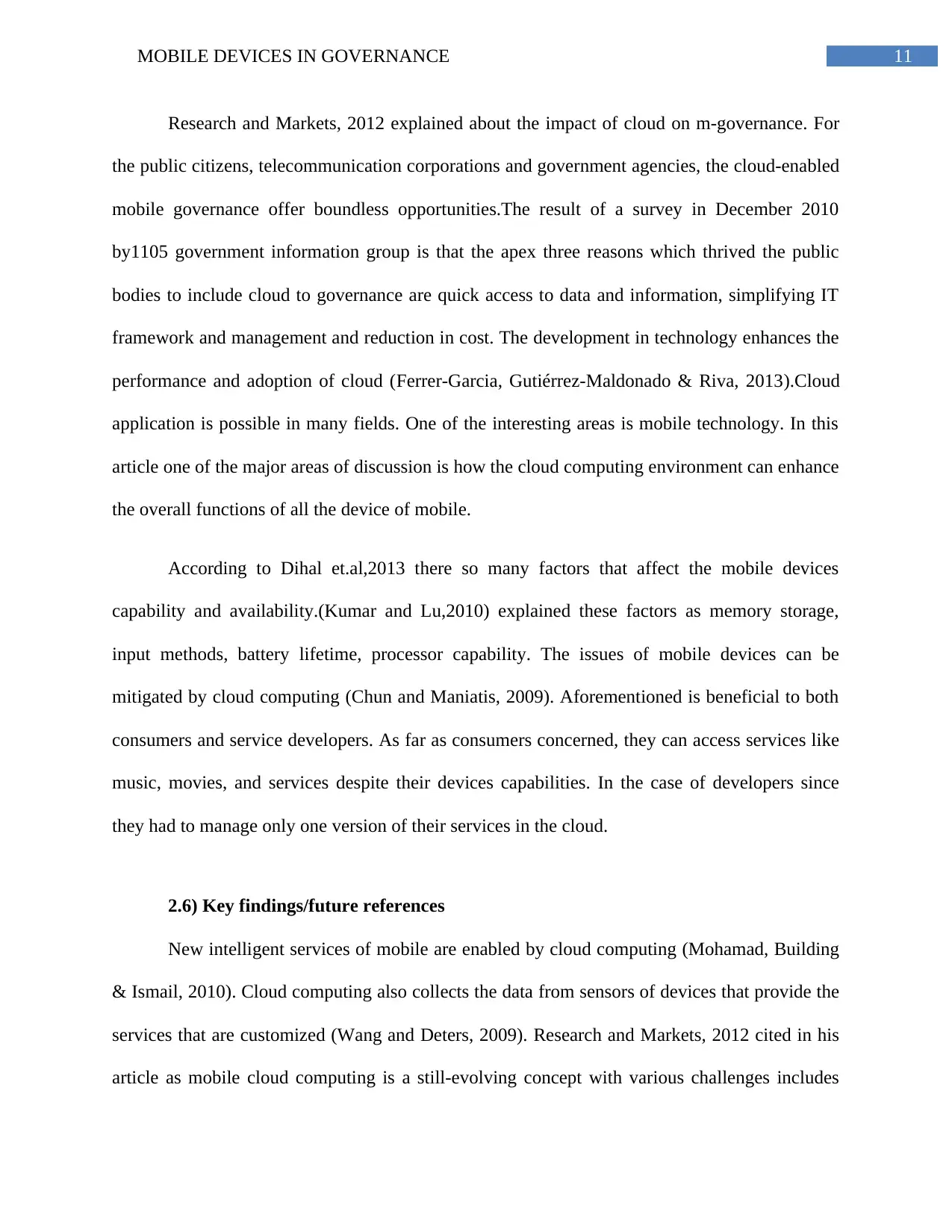
11MOBILE DEVICES IN GOVERNANCE
Research and Markets, 2012 explained about the impact of cloud on m-governance. For
the public citizens, telecommunication corporations and government agencies, the cloud-enabled
mobile governance offer boundless opportunities.The result of a survey in December 2010
by1105 government information group is that the apex three reasons which thrived the public
bodies to include cloud to governance are quick access to data and information, simplifying IT
framework and management and reduction in cost. The development in technology enhances the
performance and adoption of cloud (Ferrer-Garcia, Gutiérrez-Maldonado & Riva, 2013).Cloud
application is possible in many fields. One of the interesting areas is mobile technology. In this
article one of the major areas of discussion is how the cloud computing environment can enhance
the overall functions of all the device of mobile.
According to Dihal et.al,2013 there so many factors that affect the mobile devices
capability and availability.(Kumar and Lu,2010) explained these factors as memory storage,
input methods, battery lifetime, processor capability. The issues of mobile devices can be
mitigated by cloud computing (Chun and Maniatis, 2009). Aforementioned is beneficial to both
consumers and service developers. As far as consumers concerned, they can access services like
music, movies, and services despite their devices capabilities. In the case of developers since
they had to manage only one version of their services in the cloud.
2.6) Key findings/future references
New intelligent services of mobile are enabled by cloud computing (Mohamad, Building
& Ismail, 2010). Cloud computing also collects the data from sensors of devices that provide the
services that are customized (Wang and Deters, 2009). Research and Markets, 2012 cited in his
article as mobile cloud computing is a still-evolving concept with various challenges includes
Research and Markets, 2012 explained about the impact of cloud on m-governance. For
the public citizens, telecommunication corporations and government agencies, the cloud-enabled
mobile governance offer boundless opportunities.The result of a survey in December 2010
by1105 government information group is that the apex three reasons which thrived the public
bodies to include cloud to governance are quick access to data and information, simplifying IT
framework and management and reduction in cost. The development in technology enhances the
performance and adoption of cloud (Ferrer-Garcia, Gutiérrez-Maldonado & Riva, 2013).Cloud
application is possible in many fields. One of the interesting areas is mobile technology. In this
article one of the major areas of discussion is how the cloud computing environment can enhance
the overall functions of all the device of mobile.
According to Dihal et.al,2013 there so many factors that affect the mobile devices
capability and availability.(Kumar and Lu,2010) explained these factors as memory storage,
input methods, battery lifetime, processor capability. The issues of mobile devices can be
mitigated by cloud computing (Chun and Maniatis, 2009). Aforementioned is beneficial to both
consumers and service developers. As far as consumers concerned, they can access services like
music, movies, and services despite their devices capabilities. In the case of developers since
they had to manage only one version of their services in the cloud.
2.6) Key findings/future references
New intelligent services of mobile are enabled by cloud computing (Mohamad, Building
& Ismail, 2010). Cloud computing also collects the data from sensors of devices that provide the
services that are customized (Wang and Deters, 2009). Research and Markets, 2012 cited in his
article as mobile cloud computing is a still-evolving concept with various challenges includes
⊘ This is a preview!⊘
Do you want full access?
Subscribe today to unlock all pages.

Trusted by 1+ million students worldwide
1 out of 17
Related Documents
Your All-in-One AI-Powered Toolkit for Academic Success.
+13062052269
info@desklib.com
Available 24*7 on WhatsApp / Email
![[object Object]](/_next/static/media/star-bottom.7253800d.svg)
Unlock your academic potential
Copyright © 2020–2025 A2Z Services. All Rights Reserved. Developed and managed by ZUCOL.




